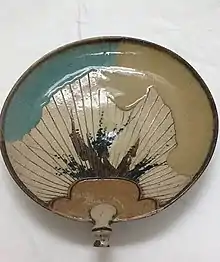
Awata ware zhun type dish, clay partly covered with drawing under a transparent, finely-crackled glaze; top covered with a thick second glaze, Edo period (19th century)
Awata ware (粟田焼, Awata-yaki) is a type of Japanese pottery that is a form of Kyō ware from Kyoto.[1]
It is related to other Kyō wares such as Mizoro ware and Kiyomizu ware, but denotes the kiln it originates from. The origin lies in the Awataguchi area of Kyoto.[2] Awata kilns also produced Satsuma ware at one point.[3]
References
- ↑ "Kyoware Rakuware/History of Japanese pottery and porcelain". history-porcelain-japan.com. Retrieved 2019-11-10.
- ↑ "Kyoto Ceramic Center". Kyoto Ceramic Art Association Official Shop and Gallery. Retrieved 2019-11-10.
- ↑ "Japanese Satsuma Pottery". gotheborg.com. Retrieved 2019-11-10.
External links
![]() Media related to Awata ware at Wikimedia Commons
Media related to Awata ware at Wikimedia Commons
This article is issued from Wikipedia. The text is licensed under Creative Commons - Attribution - Sharealike. Additional terms may apply for the media files.

